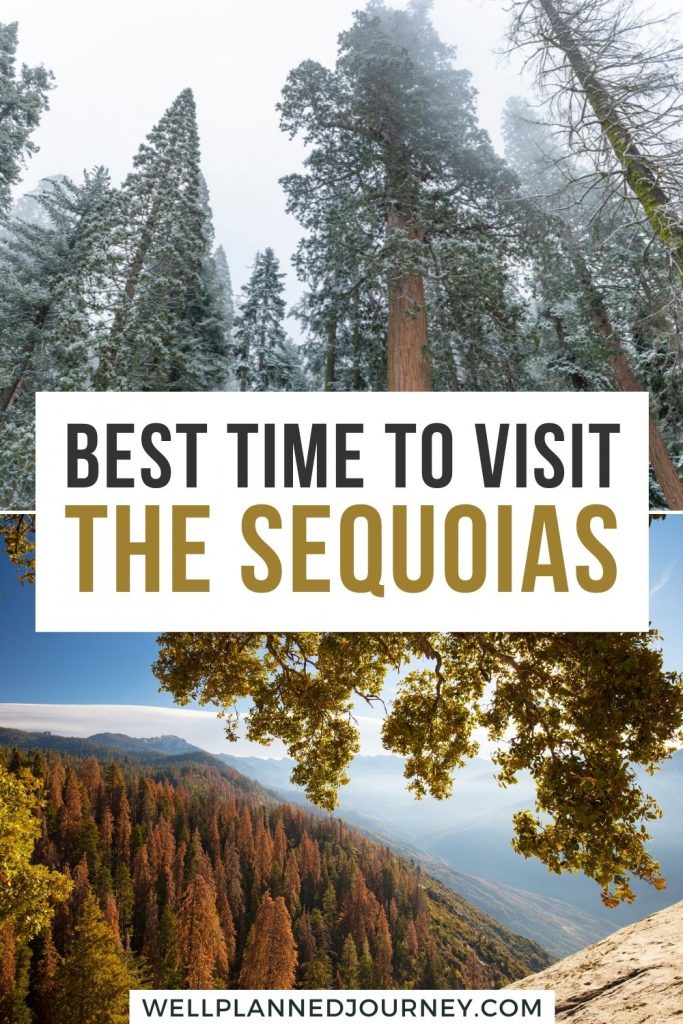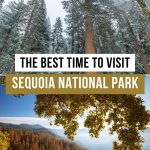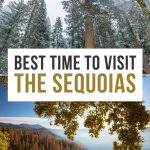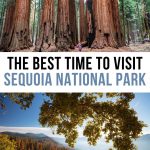Sequoia National Park is home to the giant sequoias, the world’s largest trees. More than 1 million visitors come to take in the sights and experience the sequoia groves each year.
Most of these visitors choose to go in the summer, when temperatures are warm, but is summer the best time to visit Sequoia National Park?
Each season in Sequoia National Park has something to offer. From the quiet, snow-covered sequoia groves in the winter to the busy hiking trails in the summer, there’s something for every type of traveler.
This guide covers everything you need to know about finding the best time to go to Sequoia National Park, including an overview of each season and tips on where to stay and what to pack.
This post may contain affiliate links, where I may receive a small commission at no additional cost to you. Read more in this disclosure policy.
Sequoia & Kings Canyon At-A-Glance
Before diving in, here are a few highlights to help you plan your trip:
- Best Time to Visit: Summer is the best time to visit both these national parks. From June to September, all park roads are open and the weather is perfect for hiking. If you’re looking to avoid crowds, consider visiting in May or October instead.
- Where to Stay: If you’re looking to stay in the park, you’ll have plenty of lodges and campgrounds to choose from. I recommend Wuksachi Lodge in Sequoia or Cedar Grove Lodge in Kings Canyon. Outside the parks, book a spot nearby The Parks Inn Bed & Breakfast.
- How to Get There: The closest airport is in Fresno, California. You can also fly into San Francisco or Oakland, both 4 hours away. Use Expedia to browse flights and find the best price.
- How to Get Around: The easiest way to get around both Sequoia and Kings Canyon is in your own car. Use Expedia to browse deals on rental cars or rent an RV or campervan with Outdoorsy.
- Don’t Forget: Be sure to get an America the Beautiful National Park Pass ahead of time. This $80 pass is valid for 12 months and get you into all 400+ national park sites (including both Sequoia and Kings Canyon!)
Overview of Weather at Sequoia National Park by Season
Sequoia National Park experiences all four seasons, with cold, snowy winters and hot, sunny summers. The average temperature in the park is also vastly different based on elevation through the park.
The low elevation Foothills region has mild winters with hot, dry summers. The higher elevation sequoia groves experience mild summers with plenty of snowfall in the winter.
This guide covers what to expect during each season in Sequoia National Park, including the weather, crowds, what’s open, and the best things to do.
Spring in Sequoia National Park
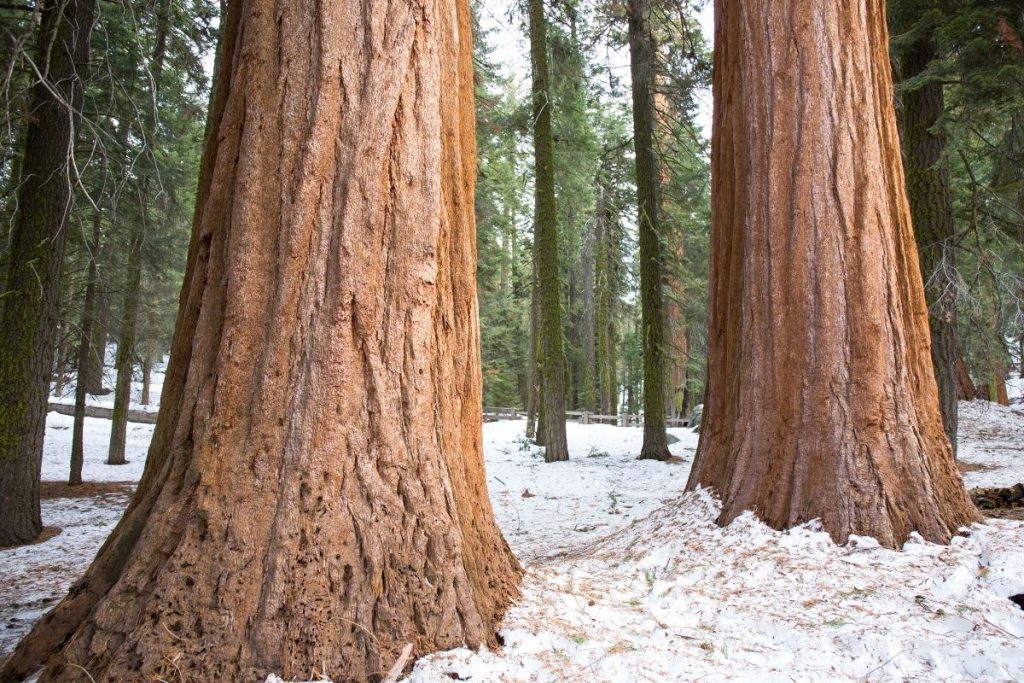
Sequoia National Park in the spring has cold nights and mild days. Spring is the rainiest season in Sequoia National Park, particularly in March and April. At high elevations like the Sequoia groves, it’s common for snow to fall through May.
If you’re visiting Sequoia in the spring, be prepared for winter-like conditions, as tire chains may be required along some park roads due to snowfall.
By late Spring, the park is alive with plenty of wildflowers in the foothills and wildlife in the Sequoias. In March, a typical day in Sequoia only sees about 2,000 visitors. By May, that number grows to nearly 4,000 visitors per day.
Spring is a great time to visit Sequoia National Park for those comfortable in colder temperatures, snowy weather, and looking to avoid crowds.
Where to Stay in Sequoia National Park in the Spring
All park lodges are open in Sequoia National Park and the Grant Grove area of Kings Canyon National Park in the spring.
This interactive map can help you search all the available hotels and rental properties near Sequoia National Park! Simply scroll and click the map below to see what is available!
These are the best hotels open in the Spring near Sequoia National Park:
- Wuksachi Lodge in Sequoia National Park
- John Muir Lodge in Kings Canyon National Park
- Grant Grove Cabins in Kings Canyon National Park
- Montecito Sequoia Lodge in Sequoia National Forest
- Rio Sierra Riverhouse outside the park
- Lazy J Ranch Motel outside the park
- The Parks Inn Bed and Breakfast outside the park
Looking to camp in Sequoia instead? These are the campgrounds that are open in the park in the Spring:
- Lodgepole Campground in the Lodgepole area
- Potwisha Campground in the Foothills region
- South Fork Campground in the Foothills region
- Buckeye Flat Campground in the Foothills region
Read more about the best campgrounds in Sequoia National Park and the best campgrounds in Kings Canyon National Park nearby.
Sequoia National Park in March
March is the coldest of the spring months in Sequoia National Park. Temperatures are cold at higher elevations (and still cool overnight in lower elevations).
Generals Highway is typically open south of Lodgepole all year, but the section from Lodgepole to Grant Grove is unplowed until the 3rd Friday in March and may be subject to closures from snow.
Roads to Mineral King and Cedar Grove (in Kings Canyon) remain closed in March. Snow chains are typically still required at higher elevations during snowstorms.
March is a great month to spend time exploring the Foothills region of Sequoia National Park.
- Average High (Sequoia Groves): 46°
- Average Low (Sequoia Groves): 26°
- Average High (Foothills): 64°
- Average Low (Foothills): 41°
- Rainy Days: 8
- Snowfall: 40.0 inches
- Average Daily Visitors: 2,500
Sequoia National Park in April
April sees rising temperatures compared to March but still experiences cold temperatures and snowy conditions at high elevations. In the Foothills, temperatures are warm with cool nights.
Rainy days are fewer, and snowfall decreases significantly compared to March. Typically, the road from Grant Grove to Cedar Grove (in Kings Canyon) opens for the season on the last weekend of April.
The road to Mineral King remains closed in April. If visiting in April, be prepared for potentially snowy driving conditions at higher elevations.
April is a great month to spend time exploring the Foothills region of Sequoia National Park.
- Average High (Sequoia Groves): 51°
- Average Low (Sequoia Groves): 30°
- Average High (Foothills): 70°
- Average Low (Foothills): 46°
- Rainy Days: 6
- Snowfall: 25.6 inches
- Average Daily Visitors: 3,480
Sequoia National Park in May
By May, spring is in full swing in the Foothills area of Sequoia National Park. Temperatures are commonly in the upper 70s here, with wildflowers blooming and lush green grasses. Unfortunately, snowstorms could carry through parts of May in the Sequoia groves, and overnight temperatures hover around freezing.
Mineral King Road typically opens the week before Memorial Day, and Generals Highway is fully accessible in May. Tours of Crystal Cave begin in mid-May.
May is an excellent time to explore the Sequoia groves with mild weather, avoiding the summer crowds.
- Average High (Sequoia Groves): 58°
- Average Low (Sequoia Groves): 36°
- Average High (Foothills): 79°
- Average Low (Foothills): 52°
- Rainy Days: 3
- Snowfall: 4.6 inches
- Average Daily Visitors:4,335
Summer in Sequoia National Park
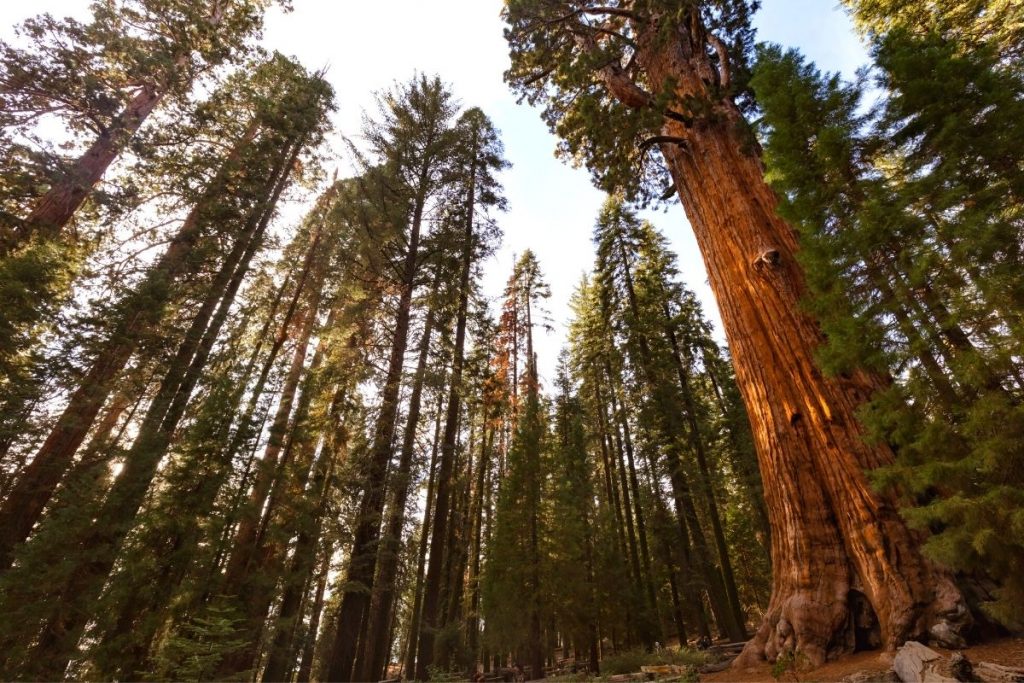
Summer in Sequoia National Park is scorchingly hot in the Foothills and comfortable in the Sequoia groves. Rainy days are few and far between.
Because of the warm weather in the Sequoia groves, summer sees an influx of crowds. A typical summer day gets nearly double the number of visitors as a fall or spring day. In Summer, all park roads and campgrounds are open.
For those looking to go backpacking and explore Sequoia’s wilderness, the summer is the quota season for wilderness season, where only a certain number of permits are issued per day. Read more about wilderness permits in Sequoia National Park here.
Summer is a great time to explore the Sequoia groves at higher elevations and visit the Giant Forest Museum. Unfortunately, temperatures in the low elevation Foothills region are often over 90 degrees, making it a less desirable time to visit this region.
Read More: 18 Best Hikes in Sequoia National Park
Where to Stay in Sequoia National Park in the Summer
In the summer, all park lodges are open in Sequoia National Park and the Grant Grove area of Kings Canyon National Park.
This interactive map can help you search all the available hotels and rental properties near Sequoia National Park! Simply scroll and click the map below to see what is available!
These are the best hotels open in the summer near Sequoia National Park:
- Wuksachi Lodge in Sequoia National Park
- John Muir Lodge in Kings Canyon National Park
- Grant Grove Cabins in Kings Canyon National Park
- Montecito Sequoia Lodge in Sequoia National Forest
- Rio Sierra Riverhouse outside the park
- Lazy J Ranch Motel outside the park
- The Parks Inn Bed and Breakfast outside the park
Looking to camp in Sequoia instead? These are the campgrounds that are open in the park in the summer:
- Lodgepole Campground in the Lodgepole area
- Dorst Creek Campground in the Lodgepole area
- Potwisha Campground in the Foothills region
- South Fork Campground in the Foothills region
- Buckeye Flat Campground in the Foothills region
- Atwell Mill Campground in the Mineral King area
- Cold Springs Campground in the Mineral King area
Read more about the best campgrounds in Sequoia National Park and the best campgrounds in Kings Canyon National Park nearby.
Sequoia National Park in June
While snow is still possible in June at higher elevations, typically, the park is warm and accessible. By June, all park roads are open, and temperatures are perfect for hiking at higher elevations. In addition, compared to the spring months, rainy days are rare in June.
In the Foothills, average high temperatures reach the 90s, making hiking at mid-day dangerous without enough water and sun protection.
June is an excellent time to visit the Sequoia groves and popular destinations like Moro Rock and the General Sherman Tree before peak summer crowds in July/August.
- Average High (Sequoia Groves): 68°
- Average Low (Sequoia Groves): 44°
- Average High (Foothills): 89°
- Average Low (Foothills): 61°
- Rainy Days: 1
- Average Daily Visitors: 5,400
Sequoia National Park in July
July is the most popular time of year to visit Sequoia National Park. Visitors descend in masses to visit the famous Sequoia groves and see the largest tree in the world: the General Sherman Tree.
By July, snow has melted even at higher elevations. Days are hot with cooler nights. Rain is rare in the summer. July also tends to mark the beginning of the fire season. It’s common for fire bans to be in place in the park starting around July 4th weekend.
July is the most crowded month in Sequoia National Park but provides excellent weather to explore the Sequoia groves and camp in the park.
- Average High (Sequoia Groves): 76°
- Average Low (Sequoia Groves): 51°
- Average High (Foothills): 97°
- Average Low (Foothills): 68°
- Rainy Days: 1
- Average Daily Visitors: 6,285
Read More: 18 Best Hikes in Sequoia National Park
Sequoia National Park in August
August, much like July, is a popular time to visit Sequoia National Park. The weather is very similar to July: dry, warm days in the Sequoias and scorching temperatures in the Foothills.
Due to the higher temperatures and dry conditions, August is a high-risk time for wildfires, and fire bans will be in place within the park.
August is just as crowded as July in Sequoia National Park but provides ideal hiking weather in the Sequoia groves.
- Average High (Sequoia Groves): 76°
- Average Low (Sequoia Groves): 50°
- Average High (Foothills): 96°
- Average Low (Foothills): 67°
- Rainy Days: 0
- Average Daily Visitors: 6,135
Are you planning a national park trip but don’t know where to start? Get my free 28-page national park ebook where I break down everything you need to know to visit all 63 USA national parks.
Download your free ebook here.
Fall in Sequoia National Park
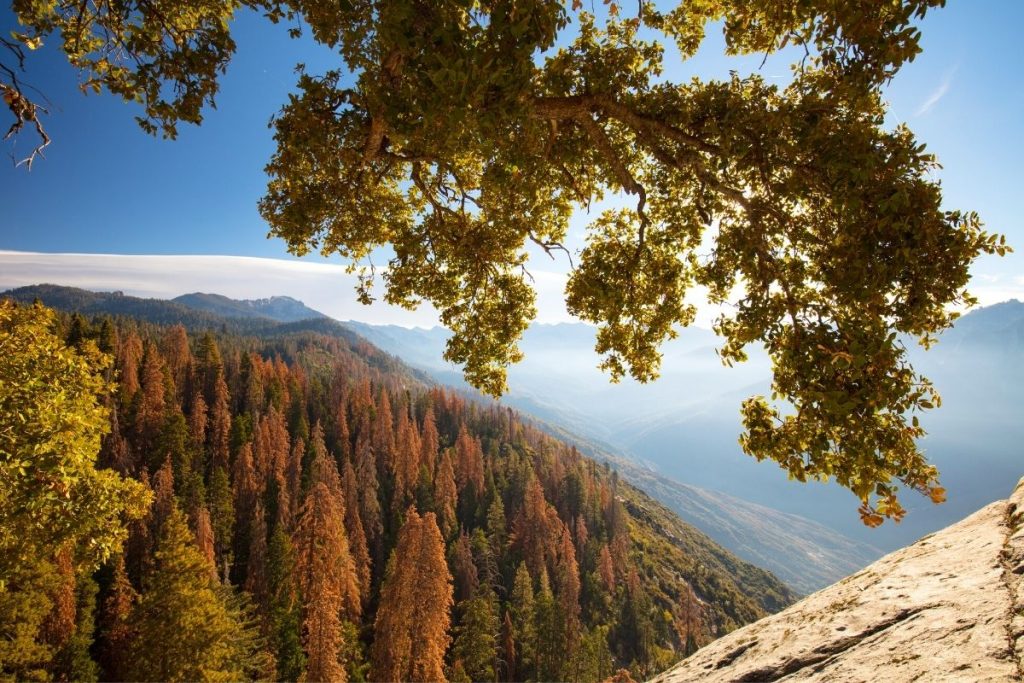
Sequoia National Park sees temperatures decline heading into fall. Dry conditions stick around through October, with limited chances of rain. The first snowfall in the higher elevation Sequoia groves is typically in late October to early November.
Crowds drop significantly after Labor Day weekend in early September. By November, only 2,000 visitors explore the Sequoias in the early wintry conditions.
Fall is an excellent time to explore Sequoia National Park without the crowds. In late fall, temperatures in the Foothills are milder, allowing for comfortable hiking weather.
Where to Stay in Sequoia National Park in the Fall
All park lodges are open in Sequoia National Park and the Grant Grove area of Kings Canyon National Park in the fall.
This interactive map can help you search all the available hotels and rental properties near Sequoia National Park! Simply scroll and click the map below to see what is available!
These are the best hotels open in the fall near Sequoia National Park:
- Wuksachi Lodge in Sequoia National Park
- John Muir Lodge in Kings Canyon National Park
- Grant Grove Cabins in Kings Canyon National Park
- Montecito Sequoia Lodge in Sequoia National Forest
- Rio Sierra Riverhouse outside the park
- Lazy J Ranch Motel outside the park
- The Parks Inn Bed and Breakfast outside the park
Looking to camp in Sequoia instead? These are the campgrounds that are open in the park in the fall:
- Lodgepole Campground in the Lodgepole area
- Potwisha Campground in the Foothills region
- South Fork Campground in the Foothills region
- Atwell Mill Campground in the Mineral King area
- Cold Springs Campground in the Mineral King area
Read more about the best campgrounds in Sequoia National Park and the best campgrounds in Kings Canyon National Park nearby.
Sequoia National Park in September
In September, temperatures cool off from the hot summer weather (although the Foothills are still hot). Rain remains rare, and conditions are dry. Expect a higher risk of wildfires and fire bans to be in place in September.
After Labor Day, crowds decrease significantly, and weather is ideal for camping in the higher elevations like Lodgepole. September is the last month to tour Crystal Cave, with tours usually running through late September. All park roads remain open through September.
September is an excellent time to explore famous sights in the Sequoia groves, like the General Sherman Tree, without as many crowds.
- Average High (Sequoia Groves): 71°
- Average Low (Sequoia Groves): 45°
- Average High (Foothills): 91°
- Average Low (Foothills): 52°
- Rainy Days: 1
- Average Daily Visitors: 4,820
Read More: 7 Best Campgrounds in Sequoia National Park
Sequoia National Park in October
October is peak fall weather in Sequoia National Park. Daily highs in the Foothills region become more comfortable, and evenings are cool. In the Sequoia groves, temperatures are crisp during the day and cold at night.
Crowds are much fewer by October, with less than 4,000 visitors per day. By late October, snow may begin to fall, and the park heads into winter. Mineral King Road closes the last week of October.
October is a great time to visit the Sequoia groves for limited crowds if you don’t mind colder weather. If you’re looking for warm October weather in Sequoia, head to the Foothills.
- Average High (Sequoia Groves): 61°
- Average Low (Sequoia Groves): 38°
- Average High (Foothills): 80°
- Average Low (Foothills): 43°
- Rainy Days: 3
- Average Daily Visitors: 3,810
Sequoia National Park in November
By November, the park’s higher elevations, like the Sequoia groves, are headed into winter. Temperatures at night are commonly below freezing, and the park gets more than a foot of snow on average.
In the Foothills, temperatures drop significantly, with mild days and cold nights. If you’re looking to hike or camp in the foothills, fall is an excellent time to do that! In November, Cedar Grove in Kings Canyon also shuts down for the season.
November is an excellent time to hike and camp in the Foothills region. However, if you don’t mind the cold and a bit of snowfall, you’re still able to explore the Sequoia groves.
- Average High (Sequoia Groves): 50°
- Average Low (Sequoia Groves): 31°
- Average High (Foothills): 67°
- Average Low (Foothills): 37°
- Rainy Days: 6
- Snowfall: 12.8 inches
- Average Daily Visitors: 2,200
Winter in Sequoia National Park

Sequoia National Park has snowy, cold winters, particularly at higher elevations. In the winter, it’s common for roads to close due to snowfall.
Roads to Cedar Grove in Kings Canyon National Park and Crystal Cave and Mineral King in Sequoia National Park remain closed for the season. In addition, from January to March, the road between Lodgepole and Grant Grove is unplowed and subject to snow closures.
Tire chains and proper snow gear are necessary when visiting Sequoia National Park in the winter.
But with the appropriate equipment, winter in Sequoia National Park provides an excellent opportunity to escape the crowds and participate in snow sports.
Where to Stay in Sequoia National Park in the Winter
In the winter, all park lodges are open in Sequoia National Park and the Grant Grove area of Kings Canyon National Park.
This interactive map can help you search all the available hotels and rental properties near Sequoia National Park! Simply scroll and click the map below to see what is available!
These are the best hotels open in the winter near Sequoia National Park:
- Wuksachi Lodge in Sequoia National Park
- John Muir Lodge in Kings Canyon National Park
- Grant Grove Cabins in Kings Canyon National Park
- Montecito Sequoia Lodge in Sequoia National Forest
- Rio Sierra Riverhouse outside the park
- Lazy J Ranch Motel outside the park
- The Parks Inn Bed and Breakfast outside the park
Looking to camp in Sequoia instead? These are the campgrounds that are open in the park in the winter:
- Potwisha Campground in the Foothills region
- South Fork Campground in the Foothills region
Read more about the best campgrounds in Sequoia National Park and the best campgrounds in Kings Canyon National Park nearby.
Sequoia National Park in December
December in Sequoia National Park is the least visited month. Snow and rainy days are common. Weather in the higher elevation is cold and often blanketed in snow.
Roads to Cedar Grove, Mineral King, and Crystal Cave remain closed. Tire chains are needed when driving Generals Highway after a snowstorm.
If you’re interested in avoiding crowds and uniquely seeing the Sequoias, December is a great time to visit.
- Average High (Sequoia Groves): 44°
- Average Low (Sequoia Groves): 27°
- Average High (Foothills): 58°
- Average Low (Foothills): 36°
- Rainy Days: 8
- Snowfall: 28.8 inches
- Average Daily Visitors: 1,455
Sequoia National Park in January
January is a popular time to visit Sequoia National Park to snowshoe and cross-country ski. In the winter, many of the trails are open for cross-country skiing. The park also offers shuttle services throughout the Giant Forest area of the park for winter visitors. Of the winter months, January is the busiest, with just over 2,000 daily visitors.
In January, the road between Lodgepole Campground and Grant Grove is unplowed and may close after a snowstorm. In addition, roads to Cedar Grove, Mineral King, and Crystal Cave remain closed.
January is an excellent time to snowshoe or cross-country ski in Sequoia National Park.
- Average High (Sequoia Groves): 42°
- Average Low (Sequoia Groves): 24°
- Average High (Foothills): 57°
- Average Low (Foothills): 36°
- Rainy Days: 8
- Snowfall: 37.0 inches
- Average Daily Visitors: 2,100
Sequoia National Park in February
February in Sequoia National Park continues to see cold weather and snowy conditions. In fact, February and March are the snowiest months in Sequoia National Park.
In February, the road between Lodgepole Campground and Grant Grove is unplowed and may close after a snowstorm. In addition, roads to Cedar Grove, Mineral King, and Crystal Cave remain closed.
February is a great time to visit for those looking to cross-country ski or snowshoe amongst the Sequoias.
- Average High (Sequoia Groves): 44°
- Average Low (Sequoia Groves): 25°
- Average High (Foothills): 61°
- Average Low (Foothills): 39°
- Rainy Days: 9
- Snowfall: 38.2 inches
- Average Daily Visitors: 1,935
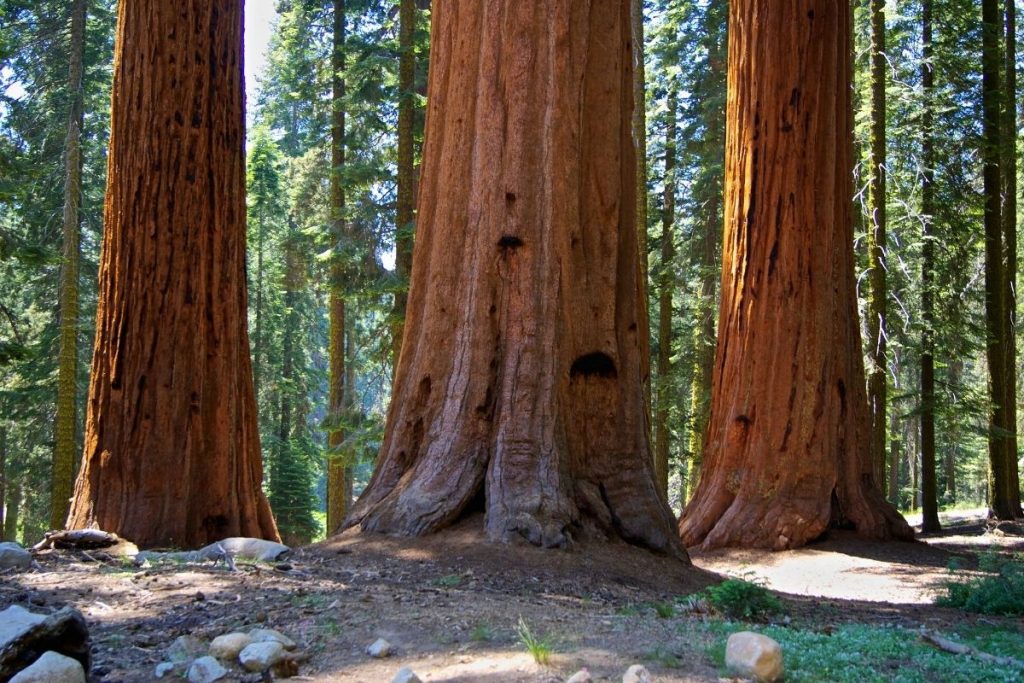
When is the Best Time to Visit Sequoia National Park?
For most visitors, June to August is the best time to visit Sequoia National Park. The weather is warm in the most popular area of the park: the Sequoia groves. While the crowds are higher in the summer, all park roads are open, and attractions are easily accessible via the park shuttle.
Best Time for Go to Sequoia National Park for Good Weather
If you’re looking for good weather for hiking and camping, visit Sequoia National Park from early June to late September. In the Sequoia groves, temperatures are warm yet comfortable. For seeing the Foothills region of the park, the weather is best from May to early June and late September to early November.
Read More: 18 Best Hikes in Sequoia National Park
Best Time to Visit Sequoia National Park to Avoid Crowds
The best time to visit Sequoia National Park to avoid crowds is from November to April. These months are colder and often snowy, deterring many visitors. However, visiting from late fall to early spring gives visitors the opportunity to snowshoe and cross-country ski throughout the Giant Forest.
Best Time to Go to Sequoia National Park to Avoid Wildfires
To avoid wildfires, visit Sequoia National Park in late spring or early summer. Wildfire season in Sequoia National Park typically lasts from July through October. Visiting in May or June provides warmer temperatures with a low risk of wildfire activity and smoky conditions.
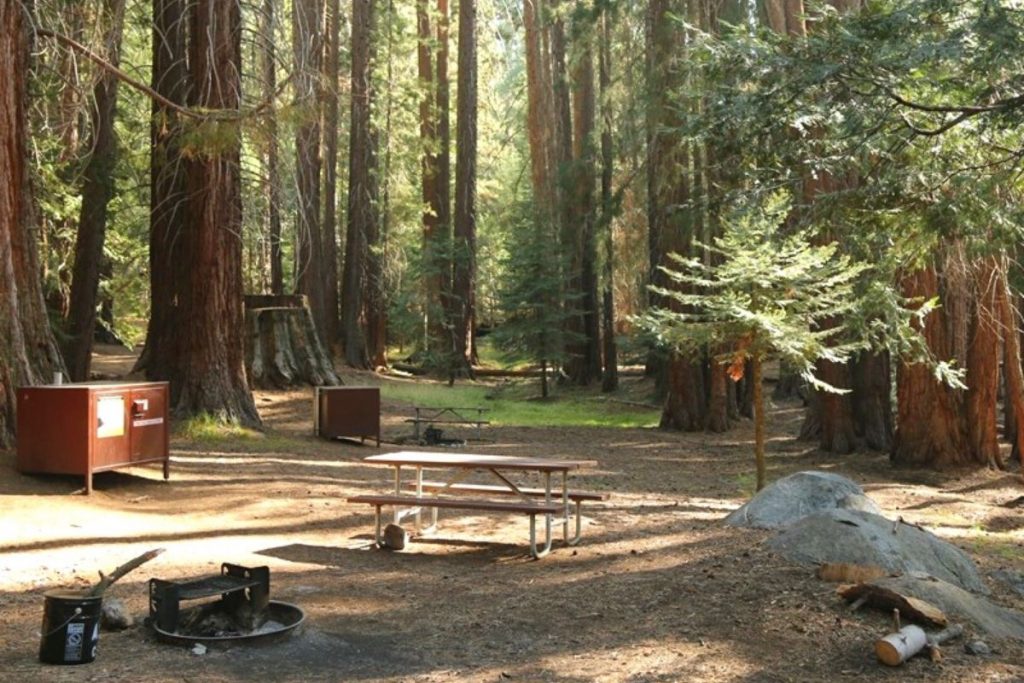
Best Time for Camping in Sequoia National Park
If you plan to camp in Sequoia National Park, the best time to visit is in the summer, from June to early September. In Summer, all park campgrounds are open and many accept reservations. If you plan to camp in the Foothills, conditions are hot in the summer. The best time to camp in the Foothills is late spring or mid-to-late fall.
Read More: 7 Best Campgrounds in Sequoia National Park
When to Visit Sequoia National Park for a Scenic Drive
The best time for a scenic drive in Sequoia National Park is from late spring or early-to-mid Fall. By May, Generals Highway is typically snow-free, and the road to Moro Rock is open. These roads stay open until mid-Fall but become very congested in the summer and often require visitors to take a shuttle.
Best Time for Seeing Wildlife in Sequoia National Park
Spring or early summer are the best times of year to spot wildlife in Sequoia National Park. Animals, like black bears and marmots, are more active this time of year. For the best chance of spotting wildlife, hike around sunrise or sunset when wildlife is most active.
Best Time for Snowshoeing in Sequoia National Park
January and February are the best months for snowshoeing or cross-country skiing in Sequoia National Park. Park rangers often offer guided tours in the Sequoia groves, and cross-country ski trails are open in both the Giant Forest and Grant Grove.
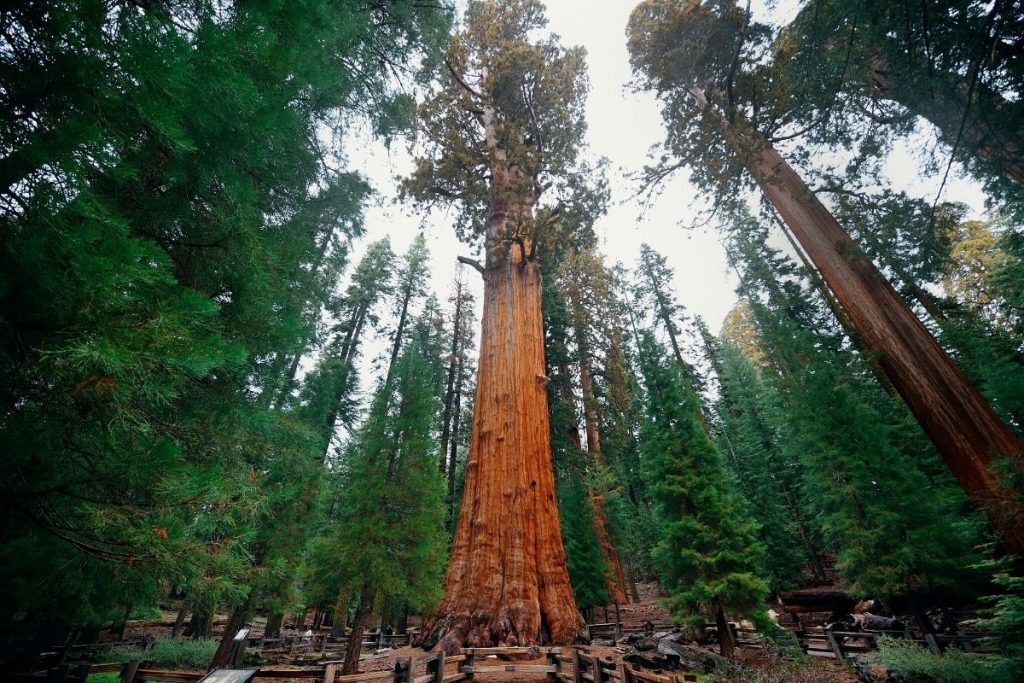
Best Time to Visit General Sherman Tree
The best time to visit the General Sherman Tree is from late Spring to early Fall. During this time, the trail is snow-free and easily to hike. If you want to avoid crowds at General Sheman, visit in the winter instead. Crowds are rare, but snowshoeing or cross-country skiing is typically required.
Best Time to Visit Moro Rock
The best time to visit Moro Rock in Sequoia National Park is during the summer, from June to September. The trail is closed in the winter months due to snowy and icy conditions. A shuttle is required during the days in the summer to reduce traffic congestion. To avoid crowds and the shuttle, visit Moro Rock for sunset instead (the shuttle typically stops running after about 6 pm, and you can drive yourself).
Read More: 18 Best Hikes in Sequoia National Park
Best Time to Stay at Wuksachi Lodge
Wuksachi Lodge is open year-round. However, it’s most accessible during the summer months when all park roads are open. If you plan to stay at Wuksachi Lodge in the winter, tire chains and snow conditions are expected.
Check prices at Wuksachi Lodge here.

What to Pack for Visiting Sequoia National Park
- National Park Pass | Sequoia National Park charges an entry fee. However, to save time when entering the park, you can use the annual national park pass. The pass gets you into both Sequoia and Kings Canyon, plus 400 more national park sites. Get your annual national park pass here for only $80.
- Hiking Backpack and the 10 Essentials | It’s essential to carry safety gear every time you hike. Be sure to pack the ten hiking essentials and bring a hiking backpack with plenty of room for water and extra equipment.
- Trekking Poles | These are a great way to reduce the impact on hikes with lots of elevation gain. I have the REI carbon fiber poles, a perfect lightweight set for any kind of hike.
- Hiking Boots | You’ll want sturdy, comfortable hiking boots or trail shoes with solid traction. Don’t forget to break in your boots before your trip!
- Merino Wool Socks | Always opt for merino wool socks. They might be a bit expensive, but they will last a long time, keep your feet dry, and protect you from blisters.
- Headlamp | If you plan on hiking for sunrise or sunset, you’ll need a headlamp to keep you safe when walking in the dark. I highly recommend the Black Diamond Storm headlamp.
- Layers | Pack moisture-wicking hiking shirts and warm fleece layers to keep you comfortable all day.
- Sun Hat and Sunscreen | Many trails are unshaded, so it’s essential to protect yourself from the sun. Of course, sunscreen is necessary, but a sun hat will go a long way towards protecting you from sunburn too.
Looking for more tips on what to pack for your trip? Check out my guides on the best hiking gear, what to pack for a road trip, and essential camping gear for all my favorite gear picks and tips to make packing for your trip a breeze!
Frequently Asked Questions About the Best Time to Go to Sequoia National Park
How many days do you need in Sequoia National Park?
To see the highlights of Sequoia National Park, you need at least two days. Spending two days in the park gives you enough time to explore the best hikes in the Giant Forest area, see General Sherman Tree and Moro Rock, and drive Generals Highway.
Is November a good time to visit Sequoia National Park?
Visiting Sequoia National Park in November provides an excellent opportunity to explore the Sequoias without crowds. November is often colder and sees some snow but is still accessible without tire chains most of the time.
Is April a good time to visit Sequoia National Park?
April is a great time to visit Sequoia National Park to avoid crowds, as long as you don’t mind a bit of snow and cold weather. Generals Highway is plowed in April but may require tire chains after snowstorms.
What months does it snow in Sequoia National Park?
Sequoia National Park gets snow at higher elevations from late October to early May. In the Giant Forest area of the park, there’s usually a deep blanket of snow from late November to May.
Final Thoughts on When to Visit Sequoia National Park
No matter the time of year, you’ll have a great trip to Sequoia National Park. Visiting in the winter requires more planning and cold-weather gear but can be rewarding with minimal crowds.
Overall, the best time to visit Sequoia National Park is in the summer, from June to September, when all park roads are open, and temperatures in the Sequoia groves are perfect for hiking.
Are you looking for more ideas for your trip to Sequoia and Kings Canyon? Check out these posts!
- 18 Best Hikes in Sequoia National Park
- 7 Best Campgrounds in Sequoia National Park
- 8 Best Hikes in Kings Canyon National Park
- 7 Best Camping Spots in Kings Canyon
Are you planning a national park trip but don’t know where to start? Get my free 28-page national park ebook where I break down everything you need to know to visit all 63 USA national parks.
Download your free ebook here.
Don’t Forget to Save This Post on Pinterest
